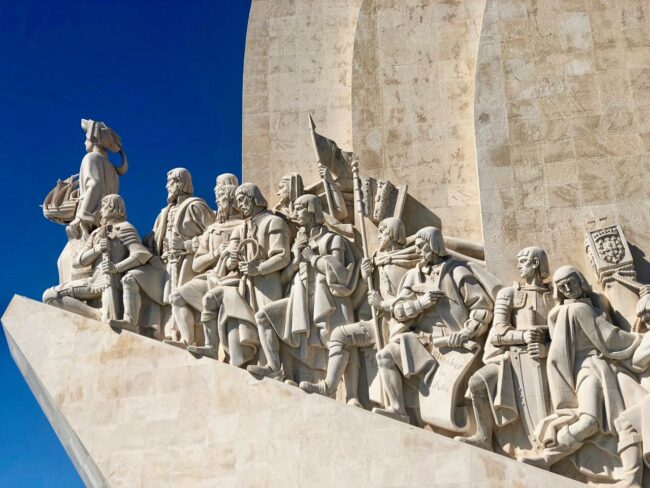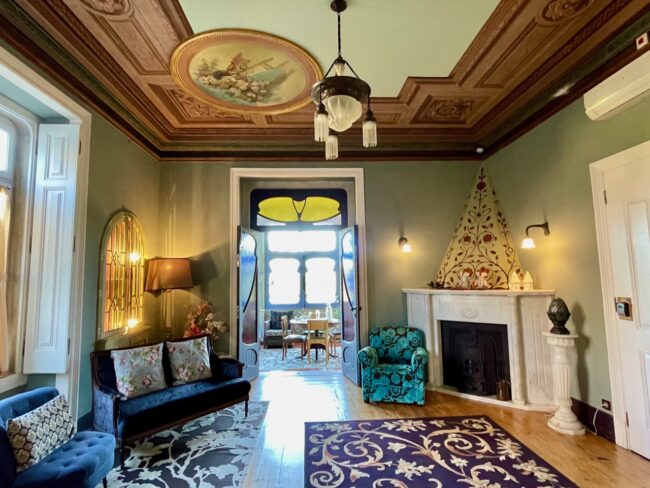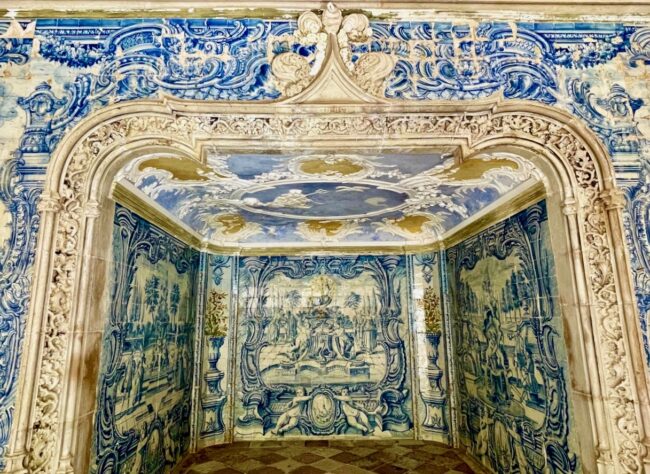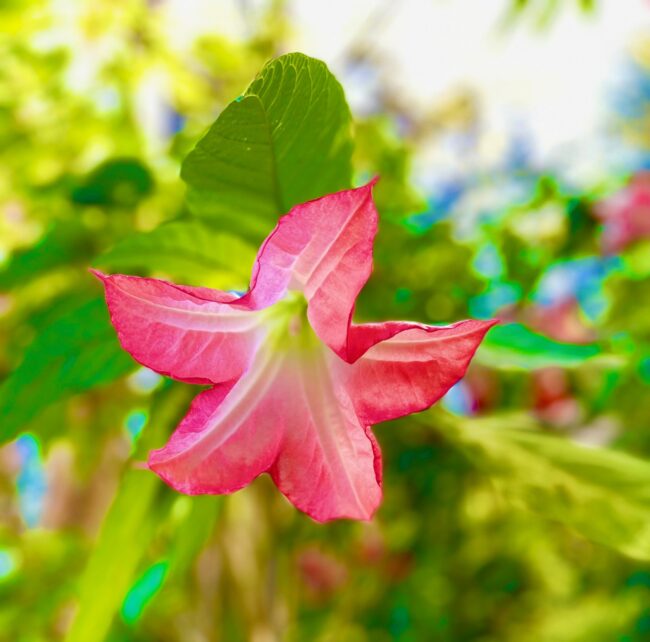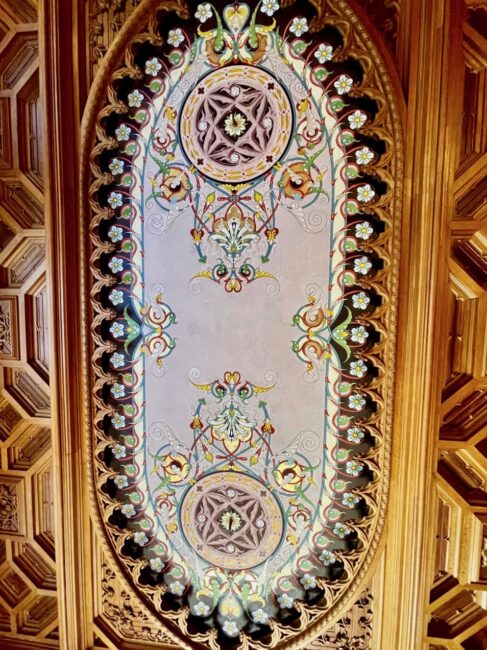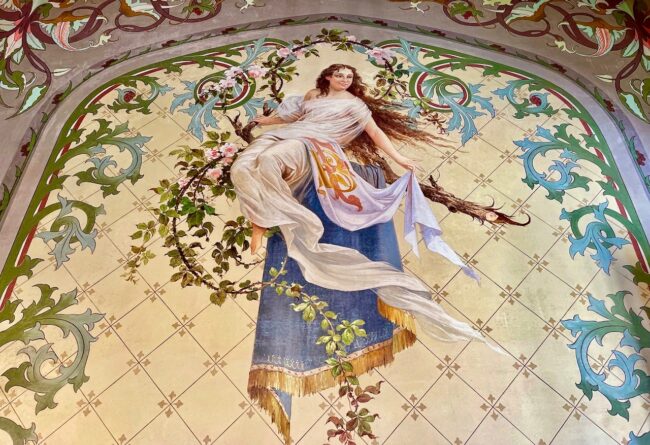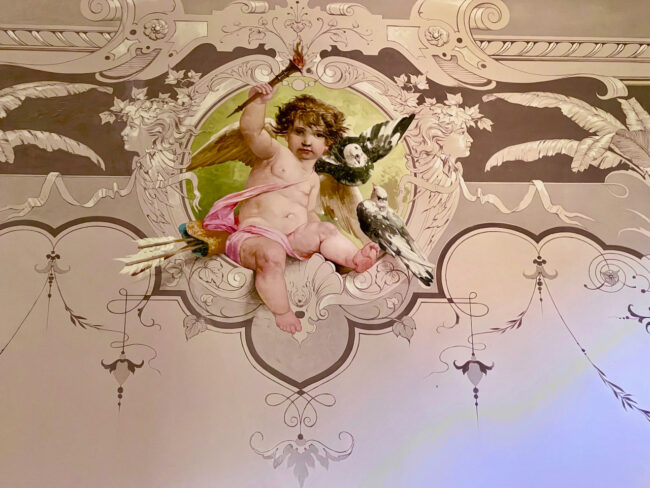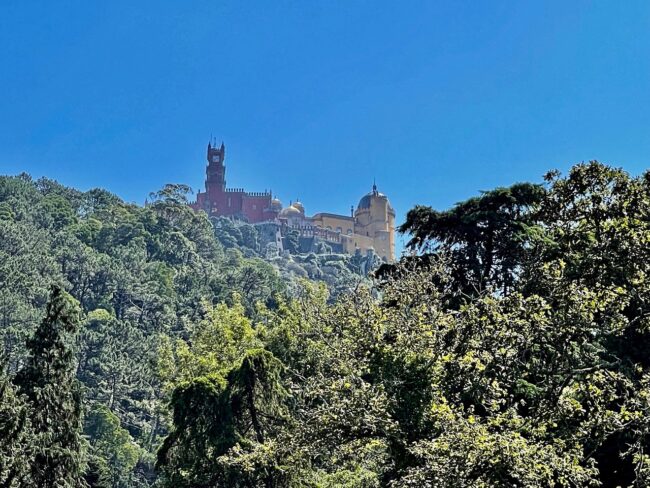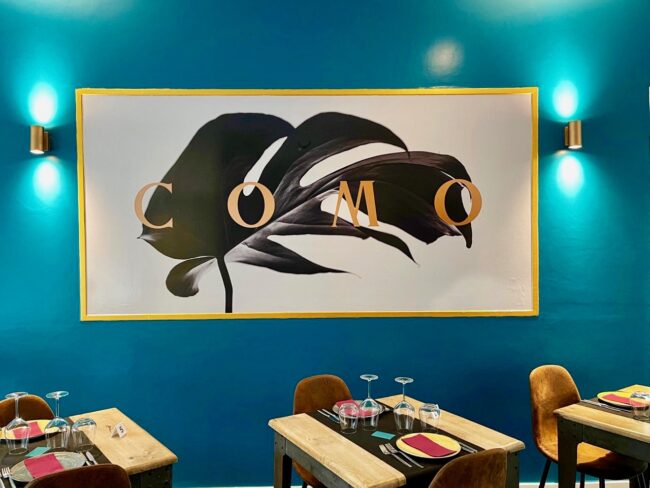
Chapter Six: Final Day In Lisbon
December 20, 2022
Chapter Eight: Quinta da Regaleira and Palácio da Pena
January 4, 2023Falling For Portugal: A Mai Tai Tom “Trip” Report
Chapter Seven: Sintra … Colorful City of Palaces
Day Seven: Beautiful Residence, The Three-Year Deposit, High Chair, Isabel Takes Over, The Oldest Palace In Portugal, Unique Tiles, Death At The Quinta, Plan B, Some Great Advice, Wine And Pringles, Where’s Perry? and Will Mary Ever Be Served?
One last rooftop breakfast at Altis Avenida, and it was time for an Uber (we had set it up with our driver from the previous day) to Sintra. Lisbon had run the gamut of spectrums offering a a little bit of everything; from spectacular historical sights, gorgeous tiled buildings, colorful street art and out-of-this-world cuisine to grittiness, poverty, abandoned buildings and not-so pleasant graffiti. One thing was for sure, Lisbon was never boring. Negotiating the numerous stairs and uphill streets, Lisbon was like our own personal stair-stepper.
A big advantage of traveling with another couple (besides instant medical attention when you take a tumble), was that we could share the Uber cost (between €35 – €40) to Sintra, plus our driver provided a non-stop narrative and overview of the town along the way. There’s a good reason why people caution you not to drive in Sintra. It is a maze of one-way streets with plenty of traffic and places where vehicles are prohibited from entering. Our driver was a little perplexed about where our lodging was located, so he pulled over to look closely at his GPS and figure it out. It didn’t take long. Looking up we noticed he had parked virtually in front of the Chalet Saudade – Vintage Guest House, where we would stay the next three nights.
It was almost like I personally knew our host Filipa at Chalet Saudade upon arrival. I had made the deposit to stay here in 2019, and each year we had to cancel thanks to Covid. In a nice gesture, each year they rolled the deposit over, and finally we made it. We were greeted by the always personable, patient and funny Filipa. Reviews are spot on, this is a great place to stay (more later). It had a beautiful sitting area and cozy back room to enjoy some vinho or port later in the day and evening.
Since it was just barely 10 a.m. the rooms were not ready, but that was no problem. Filipa told us to leave our bags in reception and go about our day. That was good, because we had someone we needed to meet.
Before leaving for Portugal, thanks to the always great advice from Maribel, I had booked a tour of Palácio Nacional de Sintra and Quinta da Regaleira with Isabel of Lisbon Tour Guides. We were to meet at 11 in front of the National Palace. Donning my new hat, we embarked on a ten-minute stroll through town. “What do you think, Sinatra in Sintra?” I asked. Mary responded, “To be perfectly Frank, not so much.” Well, I guess That’s Life, although I still like to do things My Way.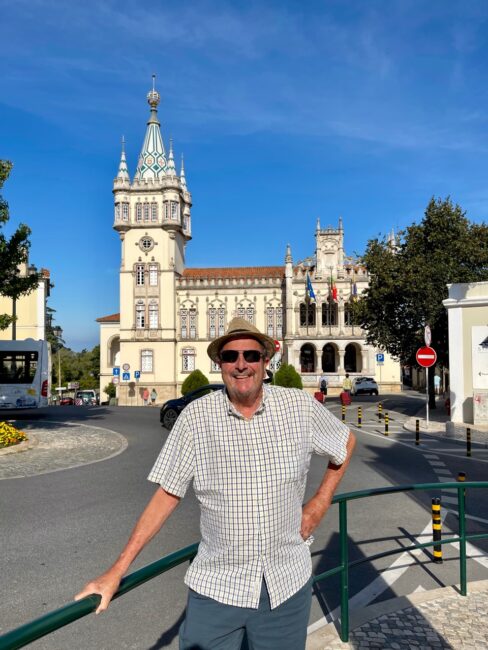
We passed the impressive Câmara Municipal de Sintra (Sintra Town Hall), a castle-like structure constructed in 1909 that looks like it could be right out of a medieval fable.
As we walked through Sintra’s historic center, what looked like cones on the roof of the palace loomed over the buildings. Indeed it was our destination the Palácio Nacional de Sintra.
For some odd reason our group always seems to be enamored with street art with oversized chairs. Today would be no exception.
 Of course, some people take a little longer to get in them. I blamed the extra weight of the hat.
Of course, some people take a little longer to get in them. I blamed the extra weight of the hat.
We reached the palace ten minutes early, and Isabel easily recognized our motley crew and we recognized the red fan she said she would be carrying. It was too late for her to turn back now. The palace is believed to have been started during Moorish rule. Construction on the Palácio began in earnest in the early 15th century by by King João I (who was also Henry the Navigator’s father) and has been updated numerous times in the intervening years, thus making the Palácio Nacional de Sintra the oldest surviving palace in Portugal.
One of the reasons the palace was built in Sintra was so the royals, especially Queen Philippa, could escape the heat of Lisbon’s summers (and the fall, which we could attest). Other wealthy ‘Lisboetas’ took their lead, and many colorful mansions and homes were built in Sintra, whose hillside location provides a cooler climate, although still not that far from Lisbon.
Also known as Palácio da Vila, we started our tour with Isabel leading the way. As we walked up the 16th-century stairs to the Sala de Entrada, Isabel gave us an overview of the palace, just part of the wealth of information and history she would impart on our tour. I had told Isabel about my stumble a few days previously, and she often told us to “watch our step.” As it would turn out, those were ominously prescient words.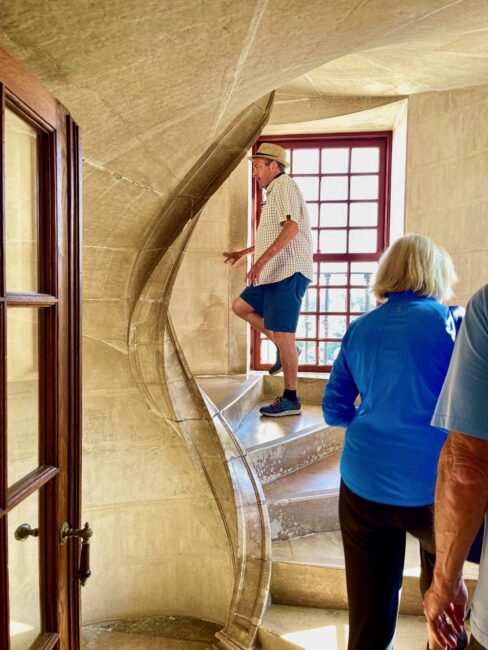
Interestingly, the initial room we entered is known as Sala dos Cisnes (Hall of Swans), the first time a swan song was actually at the beginning. The room took on many functions; musical concerts, banquets, receptions and the occasional funeral. Those hutches in the corners date all the way back to the 1600s.
It’s not difficult to figure out why. Paintings of crowned swans can be spotted on the ceiling. King João I had five sons and one daughter who was betrothed to the French Dauphin. The French king sent a gift of swans to Portugal in celebration of the marriage, and there are 27 painted on the ceiling, which was equal to the bride’s, Infanta Isabel, age.
We stepped out to the Central Courtyard, an area that allowed King João I and Queen Philippa to access different rooms without having to enter others.
Don’t tattle, but we next entered The Magpie Room. The ceiling here puts The Swan Hall to shame. There are 136 magpies on the ceiling each with the sentence “no harm meant.”
The story goes that King João was caught in the act kissing one of the ladies in waiting. He tried to explain, “Por Bem” (“Without bad meaning”). Well, that one would never pass with Tracy, but I guess Philippa was more forgiving. A lot of gossip and tattling occurred after that event, so 136 magpies were painted on the ceiling, one for every woman at his court.
The fireplace has a story, too. It was given to King Manuel by Pope Leo in 1515, and was placed at the Palace of Almerim (a palace that no longer exists). It blazed to life in 1898 when it was installed in the Magpie Room, which was utilized primarily as banquet Room.
We entered the third room of the palace, the Câmara do Ouro (Gold Chamber), a room where the king would greet people of “higher social service.”
Then, if the guests were boring he could immediately lay down and take a nap after they departed. Later in the 16th century, King Sebastião slept here with his servants and close family members sleeping on the floor. A royal slumber party.
The Garda-Roupa (Wardrobe Room) is where the royals kept their clothes, jewelry and other expensive items. I think some of the porcelain pieces are from the Ming Dynasty but I sometimes confuse my Ming bling.
It’s also called The Mermaid’s Room because mermaids are floating in air on the ceiling (this photo captured by someone on the internet with better light … and camera).
Plus I think every dressing room should contain a pig’s snout decorative piece.
On display in the Camarin of the National Palace is historic globe. It’s also unique, as it “represents the celestial sphere, with constellations and signs of the zodiac.” Made by German-born Christopher Schissler The Elder in 1575 it “reflects everything that was known about the universe at the time,” and is the only known 16th-century globe of its kind, not to mention being the oldest globe in Portugal.
Walking into the Galley Room, I felt I was listing a little bit. This was put in by João III in the 16th century to interlink the main chambers with the northwest wing of the Palace.
In the room are painted galleys flying the flag of Portugal and the Ottoman Empire. Speaking of which I could have used an ottoman to put my feet on my about now.
It was mind-boggling to think we were seeing many of the original artifacts from 500-600 years ago. It is one of Europe’s best-preserved palaces. In the 16th-century Portugal experienced an economic boon due to the India spice trade, and the tiles found in this palace I was told are seen only at the Alhambra in Granada, Spain. That’s because King Manuel I of Portugal imported azulejos from the Alhambra Palace.
Speaking of azulejos, next we entered the spectacular Sala dos Brasões (Heraldic Hall). Wow! King Manuel I had the Coats of Arms of 72 noble families painted throughout. This room is decorated with panels of azulejos dating from the 18th century.
It had us looking up once more. On the ceiling is a painting of a stag, which represents the “Symbol of Justice.”
There was no ceiling as to the amount of photos Kim and Tracy took of it.
Azulejos surround the room on the walls. They show hunting scenes and acts of gallantry.
Originally built in the 13th century, the chapel t(he earliest surviving part of the palace, possibly built during the reign of King Dinis I in the early 14th century) was enlarged in the mid 15th century. Part of the chapel is going through a renovation as of fall 2022.
The green tiles came to Portugal with King Manual I who had visited the Alcazar and Seville when he married Isabella, eldest daughter of Queen Isabella I of Castile and King Ferdinand II of Aragon. She was also the widow of Prince Afonso, the heir of King John II of Portugal (confused yet?). Isabella died one hour after giving birth to her only child, Prince Miguel (who died before his second birthday). Whew! Times were tough. 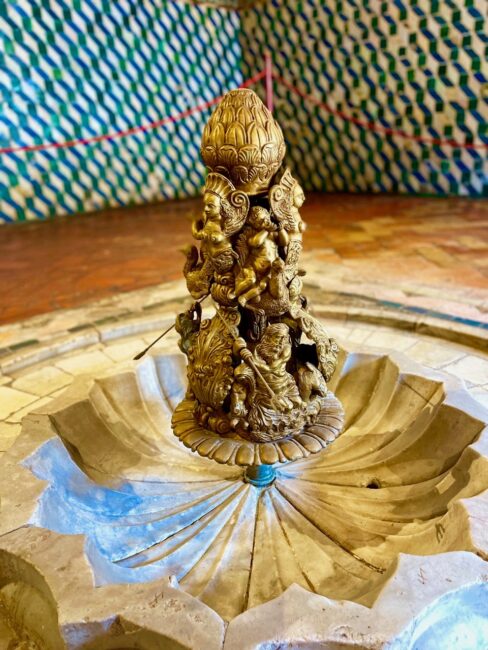
According to the palace’s website, “the Mudéjar ceiling (a painted and gilded wooden ceiling) is one of the best preserved in Portugal.”
In this room is the only 17th-century state bed in Portugal. State beds, elevated above everyone else, were usually used as a symbolic attribute of power. This was no place to sleep, but it was another place to entertain guests.
A bed similar to this is was used to display the body of King Afonso VI (1643–1683) in public after his death at the Palace in 1683. The painting is of Marie Louise of Orléans, the Queen of Spain, lying in state in the Royal Alcazar of Madrid.
The Cozinha (Kitchen) awaited.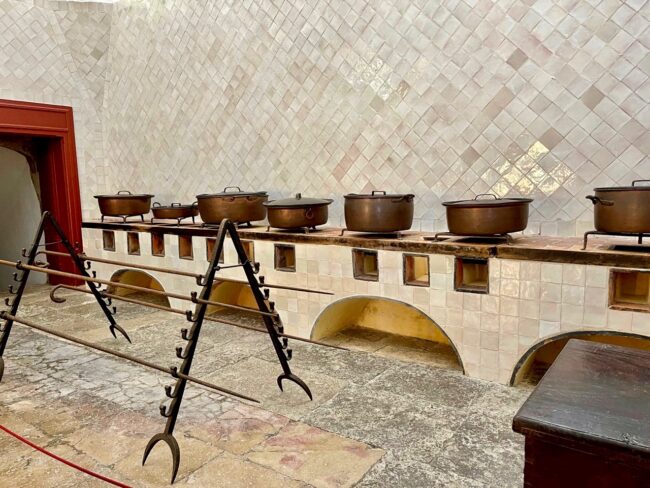
Remember those two 100-foot conical chimneys we saw when we were walking here? Well, those were built for this kitchen. The kitchen was originally a separate building because of fire.
Along the way, Isabel was giving us more tidbits of knowledge.
The Manueline Hall is quite impressive. The Great Hall was built during the reign of King Manuel.
Tracy was captivated by the light fixture and tile.
Next up was the bedroom of Pedro V.
We stepped outside for a photo op.
Back inside, we felt fortunate nobody needed to use the restroom.
I asked Tracy what room we were in now, and she replied, “the Sitting Room.” I replied, “Funny, I thought that the last room we were in was the Sitting Room.”
We made a clean getaway from the bathroom …
… and ended up in the final room of our tour, the Gruta dos Banhos (Water Grotto).
Water jets squirted from tiny holes in this area of the courtyard (not while we were there).
The Grotto was built in the late 15th or early 16th century.
The tiles depict everything from the creation of the world to the four seasons and mythological scenes. It was a colorful way to conclude our first tour of the day.
But this was only the first half of our tour with Isabel. Our next stop was scheduled to be the Quinta da Regaleira. We could see all roads lead to something important in Sintra.
It was a short, but lovely, walk to the Quinta.
We passed by Lawrence’s Hotel which is the oldest hotel on the Iberian peninsula (1764), and became known as “The Writer’s Hotel” as it hosted Lord Byron on his “grand tour” after being kicked out of England and a host of others including Danish author, Hans Christian Anderson.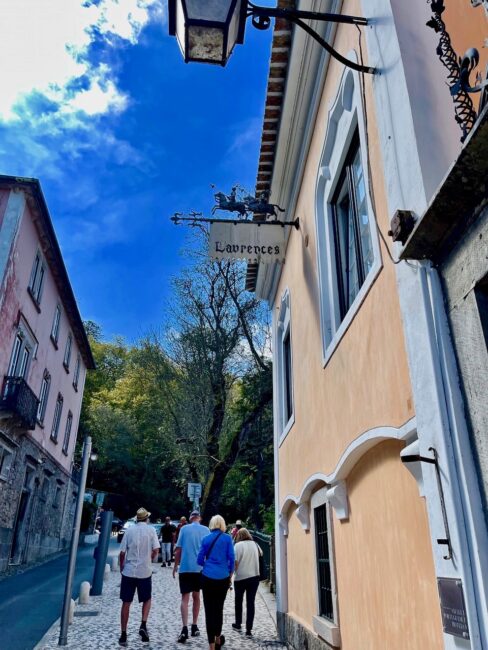
Walking by a beautiful fountain, we were close to the Quinta da Regaleira that many people describe as “magical.”
As we approached we saw people leaving, but there was still a long line to get in that didn’t seem to be moving.
When we turned the corner a policeman was directing everyone back down the hill explaining the Quinta would be closed for the remainder of the day. Isabel inquired what was going on and was told there was a medical emergency and an ambulance had been called.
We hung around for a few minutes, and soon the word started circulating that a woman had suffered a heart attack and died. The following day, it turned out to be a different story. The guard told us that a 69-year-old woman from California had fallen backward near the stable entrance, hit her head and perished from her injuries. That gave me pause to reflect on how lucky I had been.
With the Quinta da Regaleira now closed, Isabel quickly came up with Plan B. We backtracked to Biester Palace, a 19th-century Neo-Gothic/Romantic house that had just recently reopened to the public in 2022. Palacio Biester was the brainchild of Portugal’s first architect José Luis Monteiro. He utilized some of the best artists of the time to help decorate it, including Luigi Manini, one of the great Romantics in Sintra’s history. It was constructed in 1880 as the residence of Ernesto Biester, a wealthy 19th-century merchant and Portuguese playwright of German origin, who had married a Portuguese woman.
We paid our €5 old geezer price (€10 for Tracy The Younger) and entered a section of the expansive park that surrounds the palace. It was right about now I was rethinking that hat purchase. Mary was right … I’m no Sinatra.
Photogenic flora and flowers greeted us as we climbed uphill toward the house.
The park area was deigned by French landscaper François Nogré, and it includes spectacular views of Castelo dos Mouros and Sintra, including the National Palace we had just visited.
In 1999, The Ninth Gate starring Johnny Depp was partially filmed here, marking our second Johnny Depp story of 2022 (and hopefully last). Interestingly (and maddening), many of the photos we took inside never made it to the cloud and disappeared from the phone (someday I’ll figure out the cloud), so a few of the following indoor photos are from the Biester Palace website.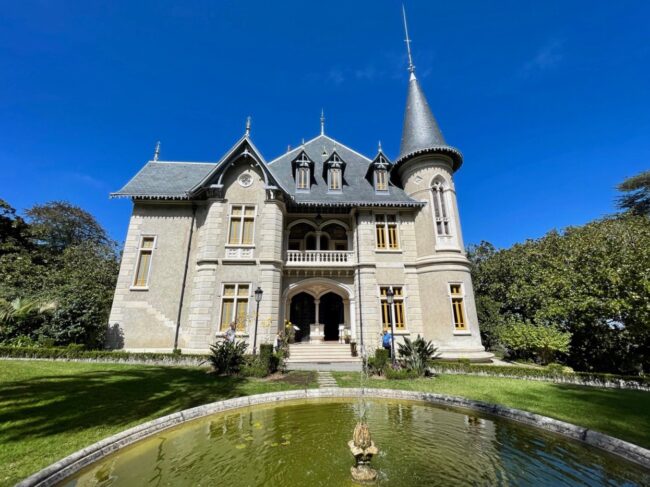
The Music Room (photo from Biester website on left) hosted many a soirée.
It was also a room where Amélia Biester could invite friends over for a quiet conversation. The stucco work, plus the walls and ceiling are very decorative.
The ceiling in the library wasn’t too shabby either. There are paintings of beasts, angels and neoclassical medallions referring to the story of Virgil’s Aeneid.
The Living Room (photo from Biester Palace) …
… is highlighted by this colorful fireplace
The Dining Room also has a gorgeous fireplace.
Many of the walls throughout the palace contain lovely frescoes.
Even the doors looked like a piece of art.
The “every palace has a chapel” theme continued here. This one is a Neo-Gothic Templar chapel, so we expected to see Angels and Demons.
The four stained glass windows came from Paris in 1899.
Before leaving we checked out the Master bedroom (photo of bedroom from Biester Palace below).
The mesmerizing ceiling art (left) and walls (right) of the Master Bedroom were created by Paul Baudry and Luigi Manini. The angel’s eyes seemed to follow you around the room. If you expand the photo by clicking it, the angel even does it on the computer.
One more room, and we were done with the interior.
It was time to explore Parque Biester …
… and Discoveries Viewpoint.
On a clear day one can see the Moors Castle, Pena Palace, Sintra Village, and even the ocean.
Fog was rolling in on the coast so we could only see a portion of the water and we would have to wait a few days to see the Royal Palace of Mafra.
We strolled through the park for awhile, but then everyone remembered we hadn’t eaten.
Isabel recommended we eat at the small tea house Biester by Casa Do Preto (their main café is in town). While we ate our pastries, Isabel told us the brief history of the Quinta do Regaleira which we would visit the following day (is it Dante’s Inferno? or was he a Mason?). She also said we should arrive early and suggested the best route to navigate the property to avoid crowds. Go straight to the big ticket item, the Poço Iniciático (Initiatic Well). and then work our way back ending with the house.
We took a detour through the town of Sintra. This sign took on an entire new meaning after today’s events.
I still regret not stopping here.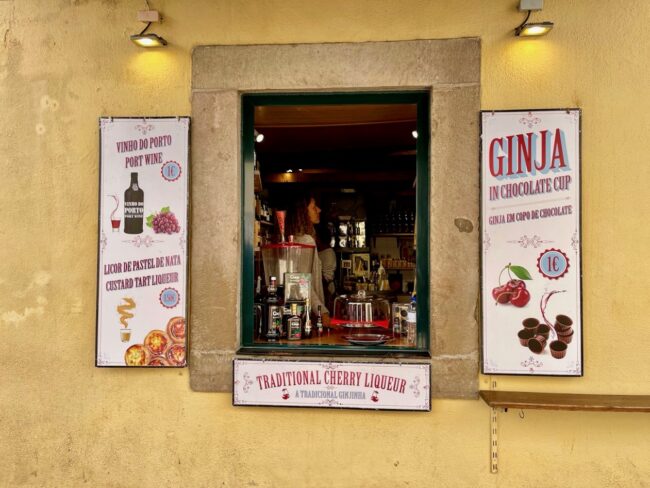
Sintra was busy as we walked upward (what else) on a Friday afternoon.
There was no stopping for more pastries either.
We bid farewell to Isabel. I highly recommend Isabel’s company (Lisbon Tour Guides) for a few hours in Sintra (or Lisbon). She was enlightening, entertaining and very informative. Thanks Isabel!
We walked the short distance back to our hotel past another pretty fountain.
I guess the pastries weren’t filling enough, so we had a late afternoon snack of Pringles, which I had not eaten since our 2009 trip to Rome, and some vinho.
Dinner was a short walk to what we thought was 100 Tachos, which had been listed as the #1 restaurant in Sintra. Tracy intimated that she’d be happy if we could purchase either one of these places.
The town hall looked good as evening dawned.
We were meeting friends and our Southern California neighbors, Bob and Maria. Maria is Portuguese and they recently purchased a house in Sintra. Arriving at the address of 100 Tachos, the restaurant situated there was now named COMO. We were told the restaurant had recently changed hands. It must have been pretty recent because it hadn’t been that many days since I made our reservations.
We sat on the patio, and things started out well.
I loved my pumpkin soup starter.
However, in what would be a continuing theme on this trip, the restaurant was out of the steak I had wanted and only had two pork cheeks left. That seemed rather odd since the restaurant had just opened a half hour previously, and crowded it was not. That should have sent out a warning bell. Maria and I ordered the last two pork cheeks.
All of us ordered, including Mary who had chosen the duck. Everyone’s dinner arrived except for Mary’s. Surely Mary’s duck would come out soon. We all started eating (except Mary). We’d ask about Mary’s meal and were assured would be out “shortly.” By the time Mary received her duck, most of us were through with dinner.
Since I attempt to Accentuate the Positive, if COMO has gotten its act together, the food was actually good, at least the food that came out on time. We bid “adeus” to Bob and Maria and returned to the hotel for a glass of port and a good night’s rest.
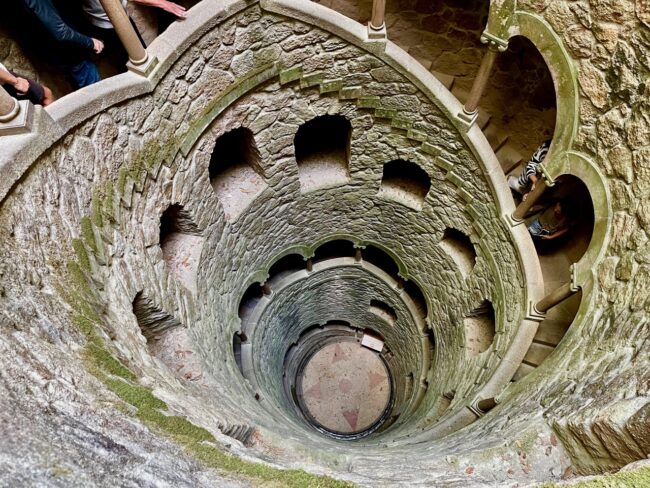 Tomorrow we’d finally see the Quinta da Regaleira, which truly does have a magical atmosphere and where we would spend the entire morning. After lunch, we would Uber about 30 minutes to the Pena Palace, where we had timed entry tickets. Getting back to the hotel would prove to be challenging. We’d end the evening at what we all considered the best restaurant we had dined at yet on this trip.
Tomorrow we’d finally see the Quinta da Regaleira, which truly does have a magical atmosphere and where we would spend the entire morning. After lunch, we would Uber about 30 minutes to the Pena Palace, where we had timed entry tickets. Getting back to the hotel would prove to be challenging. We’d end the evening at what we all considered the best restaurant we had dined at yet on this trip.
Chapter Eight: Sintra – Quinta da Regaleira & Pena Palace
Day Eight: Early Birds, All’s Well, Dante’s Inferno, Get Lost, More Manini, Crowd Control, Blown Away (Literally), The Best 20 Euro We Spent and A Neighborhood Gem


